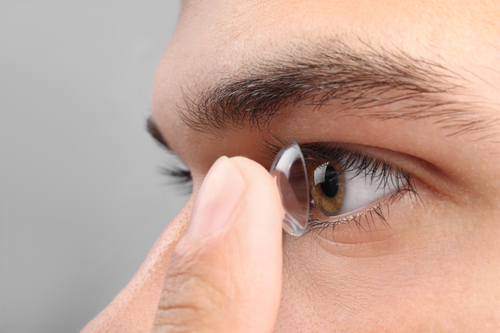
Contact lens wear is one of the common causes of dry eye syndrome. First of all, this happens if the lenses are fitted incorrectly, or if the patient somehow violates the rules for wearing or caring for them. However, it happens that even with the correct selection of optics for contact vision correction, the most careful observance of the rules for caring for it, dry eyes still bother you. Why is this happening?
The reason lies in the contact lenses themselves. The tear film has a complex composition; in addition to the water base with the salts dissolved in it, it also includes lipids, sugars, mucin. At the same time, on the surface of the eyeball, the tear forms three layers: outer (lipid), which prevents too rapid evaporation lacrimal fluid from the surface of the eye, medium (aqueous) and internal (mucin), which contributes to the processes of cell regeneration conjunctiva. Being on the surface of the eyeball, the contact lens, as it were, "cuts" the layer of the tear film. The part of the tear that is under the lens becomes insufficient to adequately moisturize and nourish the tissues of the eyeball. The tear layer on the lens surface is also too thin and evaporates quickly. There is a feeling of dry eyes, discomfort, a feeling of sand or a foreign body that has got into the eye. The lacrimal glands often react to this condition with an intensive production of tears, which does not bring relief, on the contrary, it makes it difficult to wear contact lenses, and blurred vision. The situation is aggravated by air conditioning, which is common almost everywhere in modern offices, and in many apartments too. Air conditioning systems dry the air and accelerate the evaporation of tears from the surface of the eye.
What to do? Give up the convenient contact correction of visual acuity? Fortunately, this is not necessary, but it is also unacceptable to endure, hoping that the unpleasant symptoms will disappear by themselves - the discomfort in such a situation will not disappear on its own, moreover, its severity will only worsen, which is fraught with the development of complications in the future. Therefore, to eliminate the symptoms of dry eyes during contact vision correction, it is recommended to use tear substitutes - special means that compensate for the deficit of natural tears. But you should choose such drugs that are allowed to be instilled on contact lenses, in addition, it is desirable that they do not contain preservatives.
The more pronounced the manifestations of dry eye syndrome, the more discomfort it provokes, the more intense and directed should be the restoration of the tear film on the surface of the eye. Ocutiars eye drops contain ultra-high molecular weight hyaluronic acid, which helps to alleviate the dry eye sensation that occurs after visual work, at the end working day. With more pronounced manifestations of dry eye syndrome, arising in the morning, the use of Cationorm may be indicated - the only cationic emulsion in Russia for moisturizing the eyes, which helps to restore all three layers of tears. Both Cationorm and Okutiars are tear substitutes that do not contain preservatives in their composition, which minimizes the likelihood of toxic effects of preservatives on the eye surface. Both of these drugs can be instilled directly onto contact lenses. For additional moisturizing of the ocular surface, it is possible to supplement the preparations-tear substitutes with an eye gel. Oftagel with maximum concentration of carbomer, a moisturizing ingredient that relieves dryness eye. It can be used at night after removing contact lenses.
Dry eye syndrome is a frequent companion of contact vision correction. This is a natural situation and should not be an excuse to stop wearing contact lenses. But to endure, hoping that this state will pass by itself, is unacceptable. Timely use of drugs-tear substitutes, as well as means of moisturizing the surface of the conjunctiva, will eliminate discomfort and avoid complications.
Alina Safronova, ophthalmologist, Medical and Diagnostic Center of the General Staff of the Armed Forces of the Russian Federation, St. Moscow



